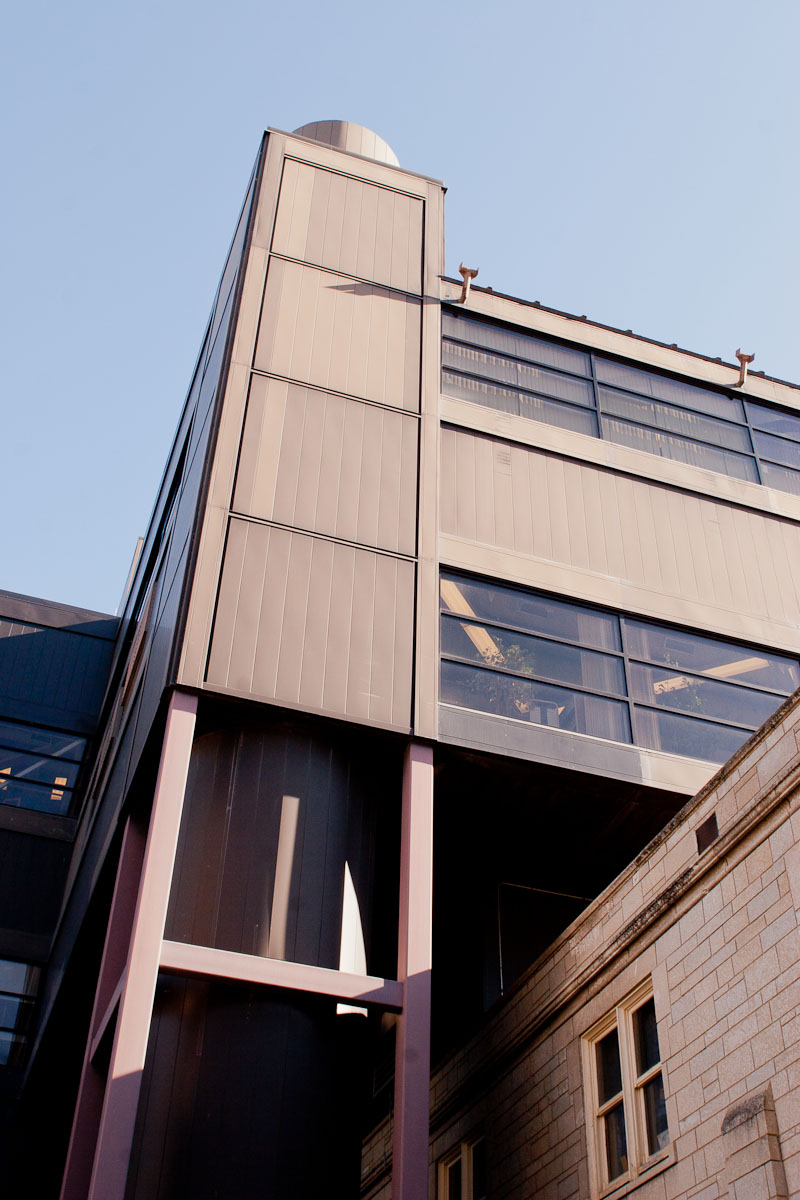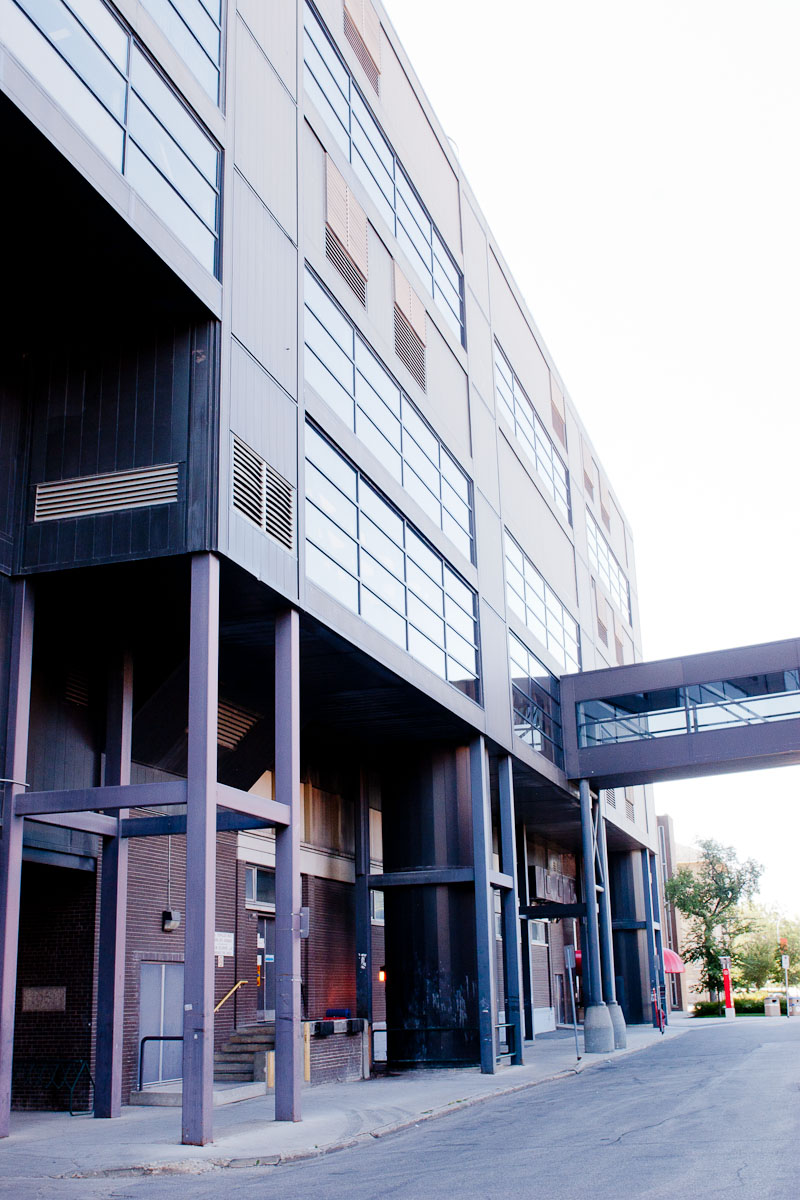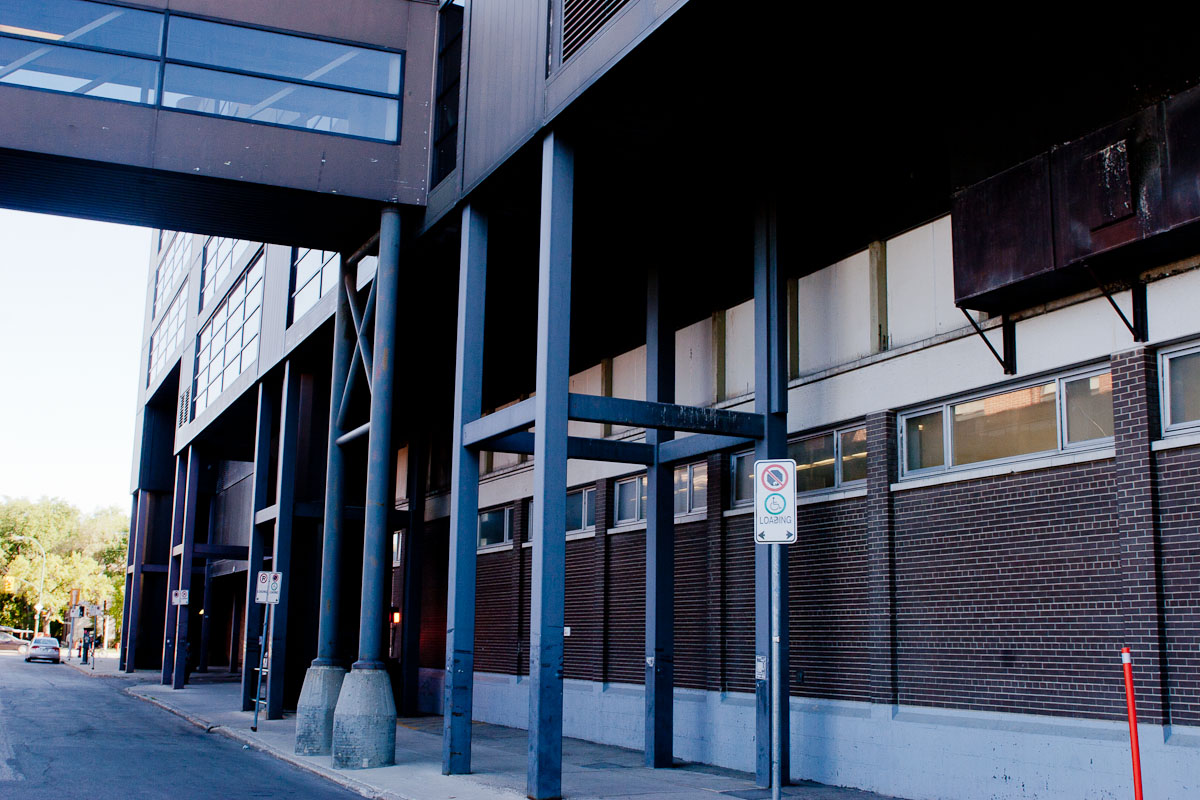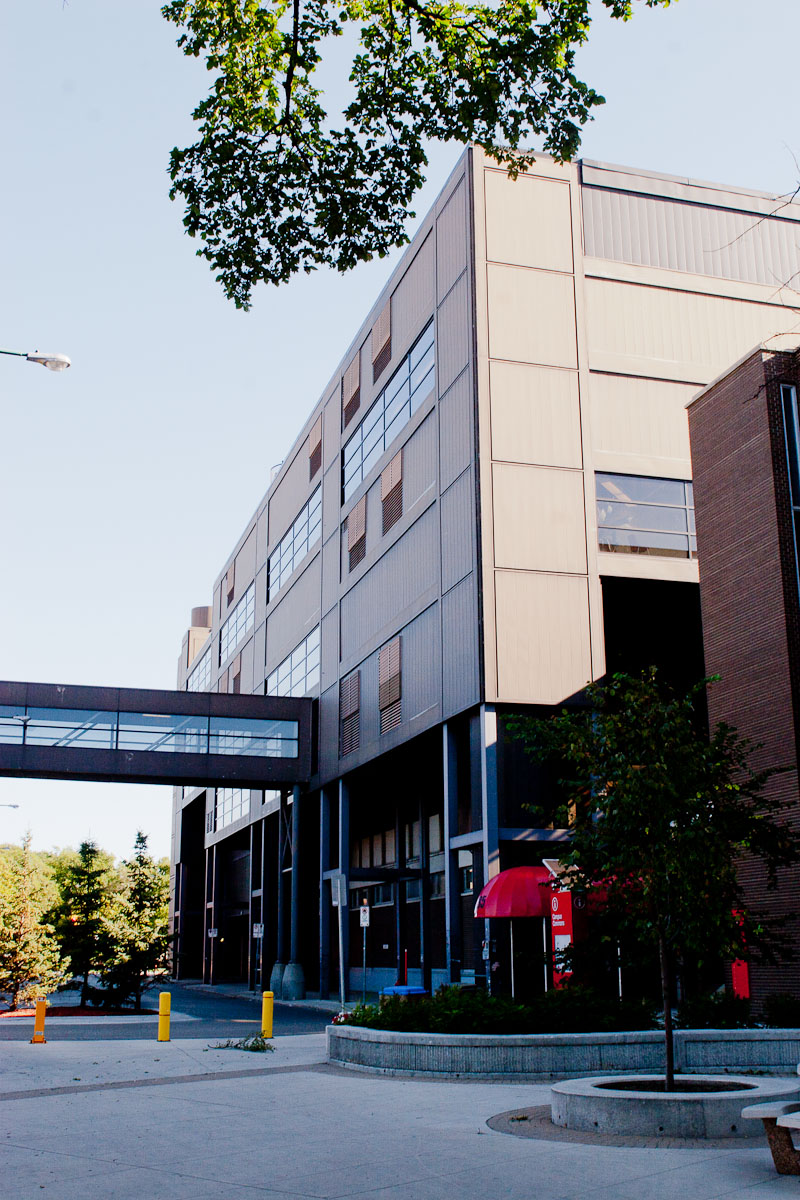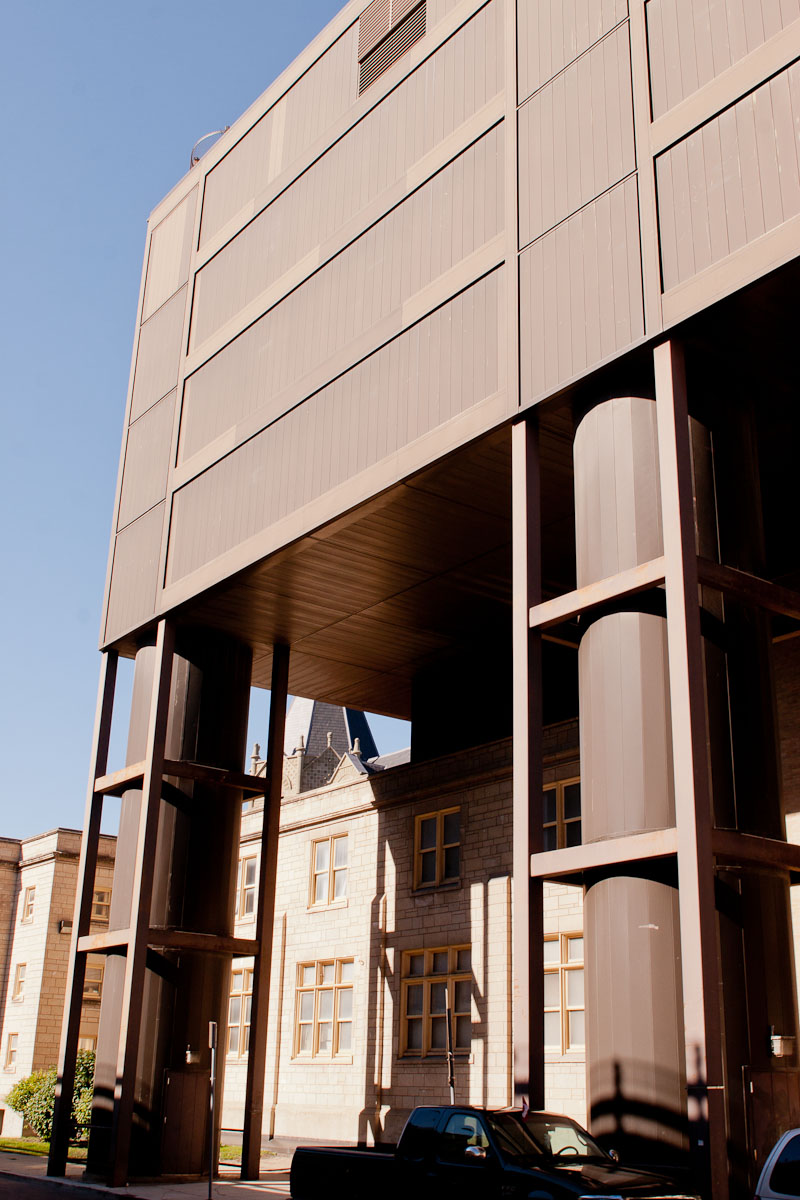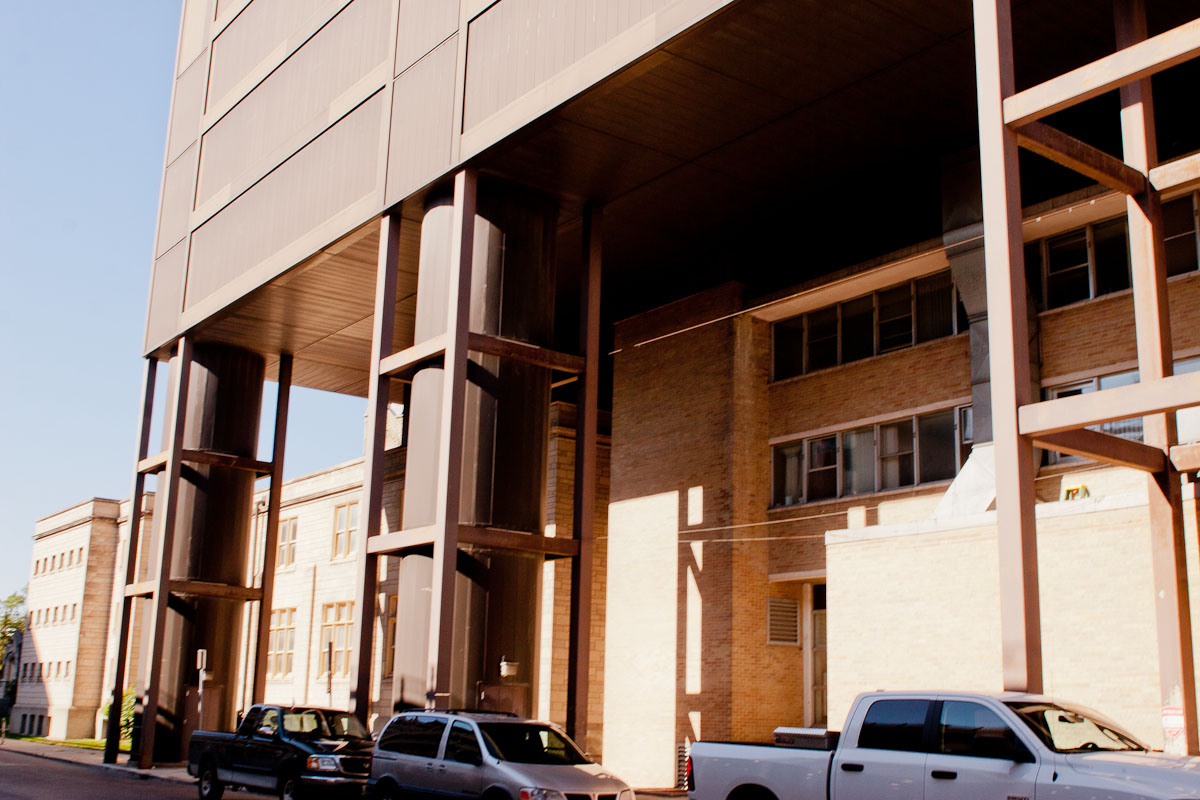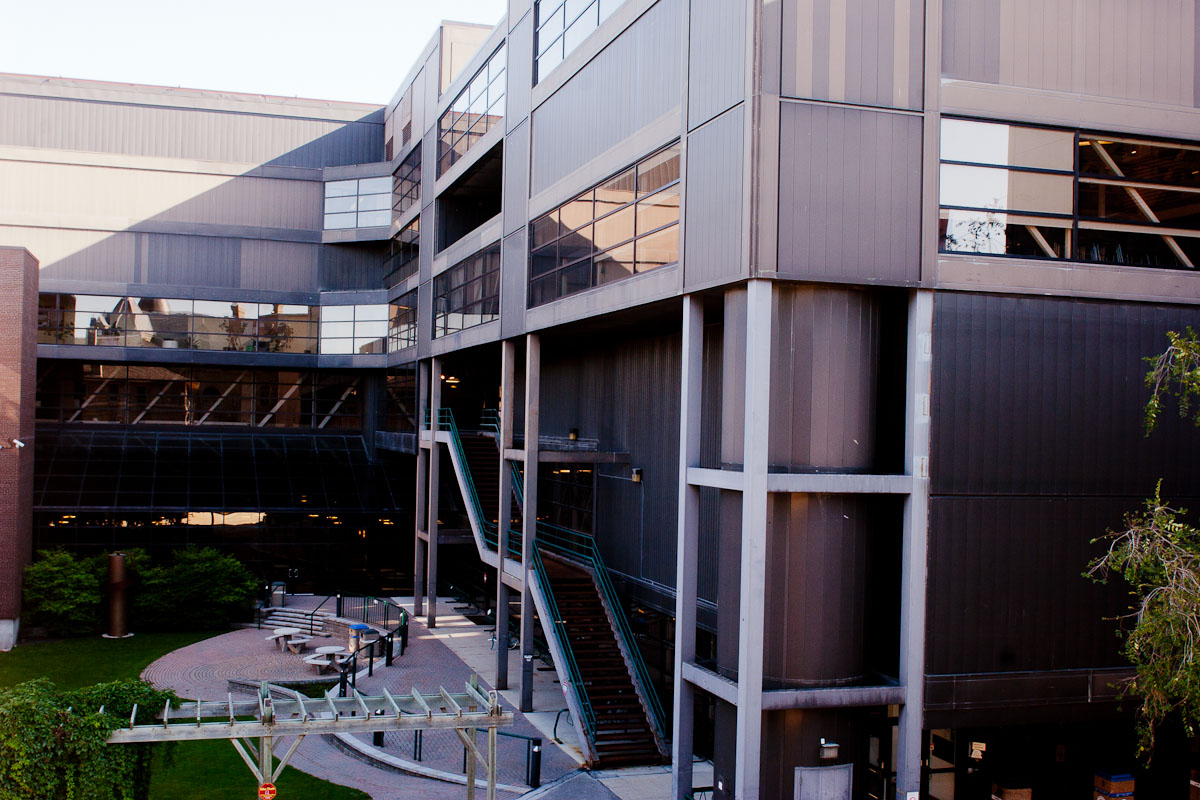Centennial Hall, University of Winnipeg
| Address: | 515 Portage Avenue |
|---|---|
| Constructed: | 1972 |
| Architects: |
|
| Firms: |
|
| Engineers: |
|
| Contractors: | |
| Guides: | Part of the QR Code Tour |
More Information
The University of Winnipeg’s Centennial Hall is considered to be one of the finer examples of late-Modernist architecture in Canada. Showcased on the cover of the March 1973 Progressive Architecture magazine, Centennial Hall received international praise after it opened in 1972. Lewis Morse, a young graduate from the University of Manitoba School of Architecture, was intrigued by the design challenges in the competition brief for the expansion. He proposed some preliminary sketches to Number Ten Architects for whom he was working at the time. Subsequently, in 1970, when Moody Moore Duncan Rattray, Peters, Searle and Christie won the contract for Centennial Hall, Morse took his innovative designs to them.
The structure anticipates the engineering and design principles later embodied in the well-known Centre George Pompidou in Paris, France (1971-1977), designed by the Italian architect Renzo Piano, the British architect Richard Rogers, and the Italian architect Gianfranco Franchini, assisted by Ove Arup & Partners. Morse worked briefly for Arup in London in 1968.
The architects designed the building both to overcome as well as to respect the limits and possibilities afforded by its urban environment. Created as a ground-scraper, the structure fills in the space between and above existing buildings on the campus. Centennial Hall features undesignated and flexible spaces, an exposed structural and mechanical system, and transparent facades, much like the Centre Pompidou. Key to many Modernist buildings is the concept of transparency, indicative in Centennial Hall’s extensive use of glass, much of which was lost through later alterations. This design was intended to consciously contrast with the formidable castellated stone exterior of Wesley Hall. The structure complemented President Henry Duckworth’s vision for the University as a non-hierarchical space of higher learning. In this sense, Centennial Hall reflects not only avant-garde architectural style of the period but also changes in educational policy and Canadian culture.
Interested in usability and economy of space, designers were concerned about pedestrian circulation in the new building. Ursula Ferguson designed visually-arresting super graphics to both direct traffic and to serve as decoration. These street signs connected Centennial Hall to President Duckworth’s vision of the city as a campus and vice versa.
In 1977, a new lecture hall and theatre were added to the structure, covering much of the glass facade in the open south-facing wall. This alteration has obscured the transparency of the original design.
In 2008, Rodney LaTourelle’s site-specific public art installation Chronochroma 6 was opened on the third floor corridor, which connects Centennial Hall with the Duckworth Centre. The multicoloured trusses pay homage to the earlier super graphics of 1972.
Over the next 10 years, the building continued to be devalued physically, as well as in the minds of faculty and students: super graphics were painted over; paint colours were changed to white; the original Canadian-designed furniture fell into disrepair; and much of the open and flexible space was filled in by subsequent, not always sensitive renovations. Some upgrading has subsequently occured but there is a real challenge having the original design and materials respected.
Centennial Hall is nationally recognised as a building of great architectural importance but little recognition has been given to it locally. Dr. Serena Keshavjee, Associate Professor of Art History, University of Winnipeg has written extensively about the building. A suggestion has been made that the university create a Centennial Hall Advisory Committee to guide all renovations of the building.
Design Characteristics
| Height: | 5 storeys |
|---|
- Structural steel frame (steel columns and exposed tube steel trusses); prefabricated steel wall, soffit and roof panels; bronze tinted glass; precast hollow core floors.
- Gross floor area: 225,000 – 250,000 square feet
- Exposed interior services and mechanical (pipes, conduit, lighting, etc.)
- 2 to 5 storeys, with mezzanines.
Sources
“Bird gets contract for enormous University of Winnipeg project.” Winnipeg Tribune, 31 July 1970.
Edinborough, Arnold. “Winnipeg’s ‘poor relation’ gets a prize — Centennial Hall.” Financial Post, 7 October 1972. 2.
Hoeschen, Susan. “U Project Demands Big Steel contract.” Winnipeg Free Press, 13 July 1971.
Jones, Mel. “$7.5 million U of W addition will ‘piggy-back old building.” Winnipeg Tribune, 29 June 1970.
Lehrman, Jonas, “Centennial Hall, University of Winnipeg.” The Canadian Architect 18 (March 1973): 33-36.
Lerhman, Jonas. “Downtown Winnipeg: A Need for New Goals.” The Canadian Architect 20 (June 1975): 44-45.
Keshavjee, Serena. ed. Winnipeg Modern. Winnipeg: University of Manitoba Press, 2006.
Secter, Marcia E. “Centennial Hall Interiors.” The Canadian Architect 183 (March 1973): 37-41.
“$8.5 Million U of W Complex Opens Saturday.” Winnipeg Free Press, 22 September 1972.
“Expansion progress at University of Winnipeg.” Winnipeg Tribune, 26 March 1971.
“Expansion ’70 — megastructure for an urban campus.” Architecture Canada Newsmagazine, 7 December 1970. 1.
“Flexibility and Informality Mark this Expansion.” Winnipeg Industrial Topics, August 1973. 5.
“University of Winnipeg Grows.” Manitoba Business Journal, 7 (April 1971): 48.
“University of Winnipeg — Unique ‘Groundscaper’ Relates to Downtown Environment.” Western Construction and Industry (August/September 1972): 4-9.
“University campus expands skyward.” Steel Design 4 (1972). A Dofasco Steel insert in The Canadian Architect 17 (April 1972): 69-70.
Canadian Underwriters’ Association, Plan Division. Insurance Plan of the City of Winnipeg, Volume I. Toronto: the authors, December 1955, partially revised 1963 and 1973. Plate #113.
City of Winnipeg. Minutes of the City Council. No 19, 27 July 1970. Minute No. 917. (Approval to proceed with an encroachment agreement with the University of Winnipeg to permit supporting columns and three cylindrical stairways to be installed on Spence and Balmoral streets for the Centennial Hall project.”
Locations of Supporting Info
University of Manitoba Libraries, Department of Archives and Special Collections, Winnipeg Tribune Subject Clipping Research Files, Microfilm Roll #148, files on “University of Winnipeg 1965-1970” and “University of Winnipeg 1971-1977.”


